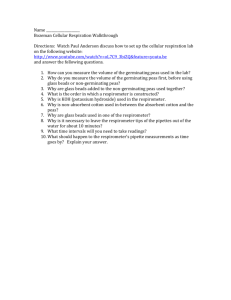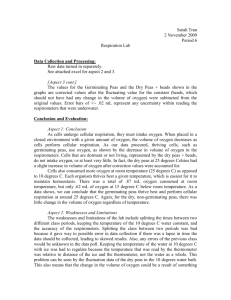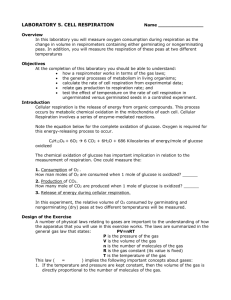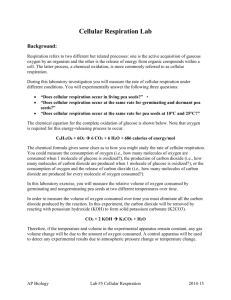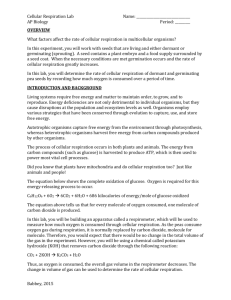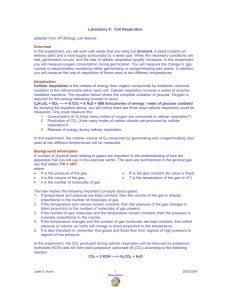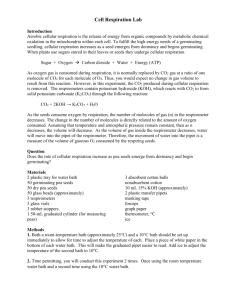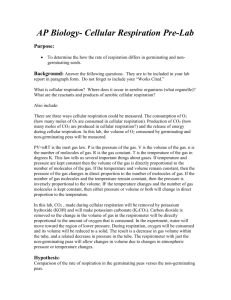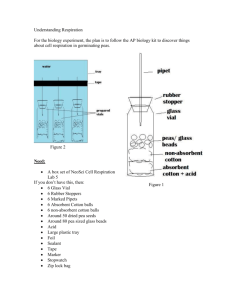LAB #20: Organismal Respiration
advertisement
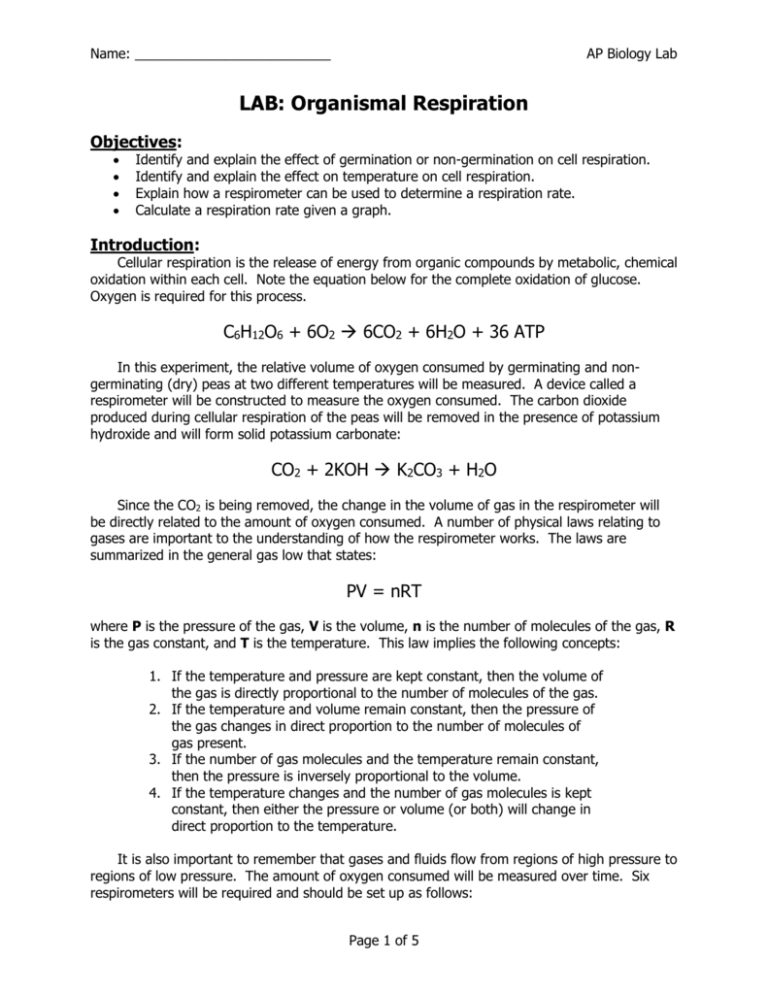
Name: __________________________ AP Biology Lab LAB: Organismal Respiration Objectives: Identify and explain the effect of germination or non-germination on cell respiration. Identify and explain the effect on temperature on cell respiration. Explain how a respirometer can be used to determine a respiration rate. Calculate a respiration rate given a graph. Introduction: Cellular respiration is the release of energy from organic compounds by metabolic, chemical oxidation within each cell. Note the equation below for the complete oxidation of glucose. Oxygen is required for this process. C6H12O6 + 6O2 6CO2 + 6H2O + 36 ATP In this experiment, the relative volume of oxygen consumed by germinating and nongerminating (dry) peas at two different temperatures will be measured. A device called a respirometer will be constructed to measure the oxygen consumed. The carbon dioxide produced during cellular respiration of the peas will be removed in the presence of potassium hydroxide and will form solid potassium carbonate: CO2 + 2KOH K2CO3 + H2O Since the CO2 is being removed, the change in the volume of gas in the respirometer will be directly related to the amount of oxygen consumed. A number of physical laws relating to gases are important to the understanding of how the respirometer works. The laws are summarized in the general gas low that states: PV = nRT where P is the pressure of the gas, V is the volume, n is the number of molecules of the gas, R is the gas constant, and T is the temperature. This law implies the following concepts: 1. If the temperature and pressure are kept constant, then the volume of the gas is directly proportional to the number of molecules of the gas. 2. If the temperature and volume remain constant, then the pressure of the gas changes in direct proportion to the number of molecules of gas present. 3. If the number of gas molecules and the temperature remain constant, then the pressure is inversely proportional to the volume. 4. If the temperature changes and the number of gas molecules is kept constant, then either the pressure or volume (or both) will change in direct proportion to the temperature. It is also important to remember that gases and fluids flow from regions of high pressure to regions of low pressure. The amount of oxygen consumed will be measured over time. Six respirometers will be required and should be set up as follows: Page 1 of 5 Name: __________________________ Respirometer 1 2 3 4 5 6 AP Biology Lab Temperature Room Room Room 10C 10C 10C Contents Germinating Seeds Dry Seeds + Beads Beads Germinating Seeds Dry Seeds + Beads Beads Procedure: 1. Both a room temperature bath and a 10C bath should be set up immediately to allow time for the temperature of each to adjust. Add ice to attain 10C. 2. Obtain a 100 mL graduated cylinder and fill it with 50 mL of water. 3. Drop in 25 germinating peas and determine the amount of water that was displaced. This will be equal to the volume of the peas. 4. Record the volume of 25 germinating peas below. Then remove these peas and place them on a paper towel. They will be used in Respirometer #1. Pea Volume _______ mL 5. Refill the graduated cylinder with 50 mL of water. Drop 25 dried (non-germinating) peas into the graduated cylinder and add enough glass beads to attain a volume equivalent to the expanded germinating peas. Remove these and place on a paper towel. They will be used in Respirometer #2. 6. Repeat procedure step 5, but this time, fill the cylinder with glass beads alone until the designated volume is reached. These will be used in Respirometer #3. 7. Repeat steps 2-6 to prepare a second set of germinating peas, dry peas plus beads, and beads for use in respirometers #4, 5, and 6 in a different temperature. SAFTEY GLASSES MUST BE WORN WHEN HANDLING KOH. POTASSIUM HYDROXIDE IS A CAUSTIC BASE. REPORT ALL SPILLS TO THE INSTRUCTOR. IF SPILLED ON SKIN, FLUSH WITH LARGE QUANTITIES OF WATER. 8. To assemble the six respirometers, obtain six vials, each with an attached stopper and pipette. Place a small piece of cotton in the bottom of each vial and, using a dropper, moisten the cotton with 1 mL 15% KOH. Make sure that the respirometer vials are dry on the inside. DO NOT GET KOH ON THE INSIDE OF THE RESPIROMETER! Pace a small wad of nonabsorbent cotton (glass wool) on top of the KOH-soaked absorbent cotton. It is important that the amounts of cotton and KOH be the same for each respirometer. (See Figure 1) 9. Place each set of germinating peas, dry peas + beads, and beads in vials 1, 2, 3 respectively, and vials 4, 5, 6, respectively. 10. Both a room temperature (approximately 25C) and a 10C water bath should be set up. 11. A sling of masking tape is attached to hold the pipettes out of the water during a 7 minute equilibrium period. 12. Vials 1, 2, and 3 should rest in the room temperature bath. Vials 4, 5, and 6 should rest in the 10C water bath. They should be weighted down to prevent them from floating. (See Figure 2) Page 2 of 5 Name: __________________________ AP Biology Lab Figure 1 Figure 2 Page 3 of 5 Name: __________________________ AP Biology Lab 13. After the equilibrium period of 7 minutes, immerse all 6 respirometers entirely in their respective baths. Work swiftly, checking for leaks. Arrange them so that the pipettes can be read through the water without having to manipulate them by hand. 14. Allow 3 more minutes to equilibrate then record to the nearest 0.01 mL the initial position of water in each pipette. This will be t = 0. 15. Every 5 minutes for 20 minutes take readings of the water’s position in each pipette and record in Table 1. 16. From the slope of the four lines on the graph, determine the rate of O2 consumption of germinating and dry peas during the experiments at room temperature and at 10C. Recall that rate = y/x . Record the rates in Data Table 2. Table 2 Condition Show Calculations Here Rate (mL O2/minute) Germinating Peas @ 10C Germinating Peas @ 25C Dry Peas @ 10C Dry Peas @ 25C Hints For Your Lab Report: The Introduction section of your lab should have (but not be limited to) your hypotheses for both variables that will be tested. A visual—graph—may be included with your hypothesis showing the respective rates of respiration. The Results section of your lab report will include: Data table 1. Graph of the corrected difference column for the germinating peas and dry peas only. This graph should have all 4 lines—2 at 10C, and 2 at 25C. Remember, we are measuring the rate of oxygen consumption. Don’t forget the regression analysis! Data Table 2, complete with calculations. The Discussion section of your lab report will include the answers to the following questions (among lots of other information—see your Lab Guide): 1. What was the relationship between the amount of oxygen consumed and time? 2. Why was it necessary to correct the pea readings with the bead readings? 3. What is the purpose of KOH in this experiment? 4. What was the effect of germination vs. non-germination on pea seed respiration? 5. What is the molecular effect of temperature on pea seed respiration? 6. Why are germinating seeds an appropriate subject in the investigation of respiration rates? Page 4 of 5 AP Biology—Lab 20 Table 1—Measurement of Oxygen Consumption by Soaked and Dry Pea Seeds at Room Temperature and 10°C Using Volumetric Methods Temp (°C ) Beads Alone Germinating Peas Dry Peas and Beads Time (min) Reading at Diff.* Reading at Diff.* Corrected Reading at Diff.* Corrected Diff. Diff. time X time X time X 0 5 10 15 20 0 5 10 15 20 * Difference = (initial reading time 0) - (reading at time X) Corrected Difference = (initial pea seed reading at time 0 - pea seed reading at time X) - (initial bead reading at time 0 - bead reading at time X)
